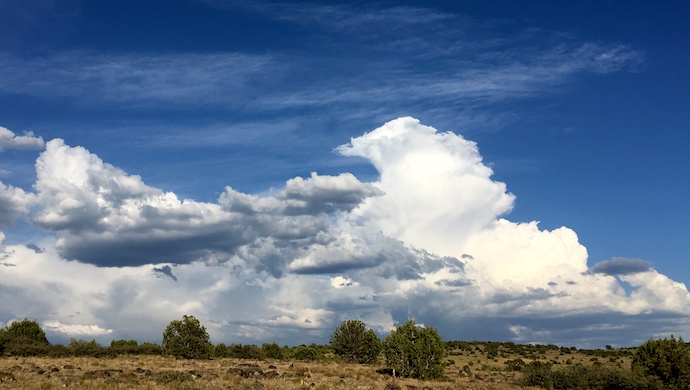The Indian Monsoon has two main components- southwestern and northeastern. The southwestern Monsoon is influenced by an ocean-atmospheric phenomenon of the Indian ocean. This phenomenon has been recently discovered and is being studied with avid interest. It is known as Indian Ocean Dipole. There is a strong correlation between the dipole and the prevalence of Monsoon in India.
Monsoon is brought by the moisture-laden winds which are in turn formed due to pressure differentials over the sea surface and land surface. This difference of pressure is guided to an extent by the SST over the seas. Sea surface temperature (SST) is the average temperature of the surface of the ocean in any geographical location which changes diurnally. There are two main sea bodies surrounding the Indian peninsula- the Arabian Sea and the Bay of Bengal. There generally remains a differential of the sea surface temperature between the Arabian Sea and the Bay of Bengal. The Indian Ocean dipole is the variation of the sea surface temperature in a sustained manner between the Arabian Sea (western Indian Ocean) and the Bay of Bengal (eastern Indian Ocean). It is also occasionally referred to as the Indian Nino. This is a case of sea surface temperature oscillation which is irregular. There are three phases of the Indian Ocean Dipole (IOD)-positive, negative and neutral. Positive IOD is the lower than normal sea surface temperatures in the eastern equatorial Indian Ocean and the higher than normal sea surface temperatures in the western equatorial Indian Ocean. Negative IOD is the prevalence of warmer than usual sea surface temperatures in the eastern equatorial Indian Ocean and the lower than normal sea surface temperatures in the western equatorial Indian Ocean. During the neutral phase of the Indian Ocean Dipole, on the ocean, overall ocean current dynamics make the surface waters of the Indian ocean to move from western part to eastern part and then in between the Indonesian islands towards the north-western Australian coast. The relatively hot air rises near the north-western Australian coast and is driven towards the west over the westerlies. Inside the bulk of seawater, there is an arrangement of water known as thermocline which is a kind of layer that separates the seawater layers with different temperatures. In this context, the thermocline can be understood as the layer separating the upper warm waters from the lower colder waters. In the positive phase of Indian Ocean Dipole, winds near the ocean surface push the water towards the east African coastline (tropical ocean current) in the western Indian Ocean. This results in the downwelling of ocean waters near the African coast. Hence, the thermocline in the Indian ocean is nearer the surface of the ocean in the eastern part of the Indian Ocean than in the western Indian Ocean. The orientation of the thermocline is just the opposite in the case of the negative phase of the Indian ocean dipole where the downwelling is near the Indonesian and Australian coasts in the eastern Indian ocean. These ocean water dynamics decide the rainfall pattern in the area from the east African coast region, through the Indian peninsula to the Indonesian region and north-western Australian coast region.
In the case of positive IOD, the East African region receives more rainfall with respect to the northwestern region of Australian. For India, the positive IOD causes delayed withdrawal of the southwestern wind pattern over the Indian peninsula and hence prolonged monsoon. This effect is like the effect of La Nina over Indian monsoon. In negative IOD, the Australian region gets more rainfall than the African region which causes the monsoon over India to be shorter as the wind patterns oppose the southwestern monsoon. This effect is just like the effect of the El Nino over Indian southwestern monsoon. Last year’s India Ocean dipole was unusually strong; some asserting that it had been the strongest in six decades. The IOD was of the positive type which caused huge rainfall and cyclones over the East African coast and drought-like conditions on the north-western Australian coast. The IOD of the current year has been predicted to be of the negative type which would mean that the monsoon in India would be shorter and be less prominent. But India has already received higher than normal rainfall in its pre-monsoon showers. The monsoon across the country has seen above the normal showers exemplified in the flood conditions from Assam to Mumbai. Can Indian Ocean dipole be the only explanatory factor in describing this abnormality?
Rainfall above the expected level cannot be described, modeled, and predicted with regards to just the Indian Ocean Dipole. The above-average rainfall of 2020 has been attributed to a higher number of western disturbances and a neutral condition of El Nino (ENSO). The tropical easterly jet is also another important deciding factor for the onset and extent of the Indian monsoon. This jet is a type of high-velocity wind in the lower troposphere. The tropical easterly jet has mainly two parts- the Somali jet and the African jet. These jets are known to be consistent in the period from June to October. Current observations have found that the prolonged heating of the Tibetan plateau (which provides a node to attract the jet) is causing stronger tropical easterly jet and as a result more rainfall over India.
On a global scale, the effects of IOD, the western disturbance, the El Nino southern oscillation, the tropical easterly jets, heating of the Tibetan plateau are being impacted by climate change. Hence, the Indian monsoon is on a causal level being affected by climate change which itself is anthropomorphic. Understanding Indian ocean dipole is necessary but not enough to predict the nature of Indian monsoon. In this regard, associations like the Climate beyond borders, which is a brainchild of the Belgian weather presenter Jill peters and supported by World meteorological organization, Intergovernmental Panel on Climate Change and UN Framework Convention for Climate Change, can be helpful platforms for India to gather expertise. India should vigorously integrate its meteorological department with such bodies to precisely understand the causal factors of the increasing or decreasing monsoon.





